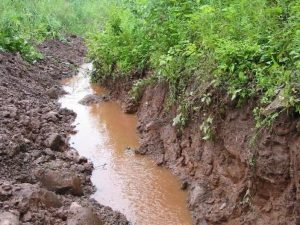 What is Nonpoint Source [Water] Pollution?
What is Nonpoint Source [Water] Pollution?
Nonpoint Source Pollution, as the name implies, is pollution that does not come from a single source, but is from many varied sources that in the end pollute our waters (whereas source pollution is more easily identified as for example, pollutants that come out of a pipe from a factory). Water that moves across and through the ground (by rainfall, snowmelt, car washing etc) carries with it manmade and natural pollutants. These pollutants eventually seep into our groundwater and drinking water supplies, and/or are deposited into our swimming areas, lakes, rivers and streams. The National Water Quality Inventory: 2004 Report to Congress identified Nonpoint Source Pollution as one of the leading sources of surface water pollution and identified that it can also contaminate groundwater.
What are Examples of Nonpoint Sources?
Water runoff from gutters and faulty storm drains
Pet and livestock waste
Excess nutrients from chemical fertilizers, herbicides, pesticides and insecticides
Improperly maintained Septic Systems
Improper disposal of chemicals (e.g. paint products, oil, gasoline, antifreeze, brake fluid)
Sediment from eroded areas
Oils from pavements and driveways (sometimes seen as a rainbow colored sheen)
Who is responsible for Nonpoint Source Pollution? We ALL are!
There are a number of ways that you can help reduce Nonpoint Source Pollution and protect Connecticut’s water resources.
What You Can Do to Prevent Nonpoint Source Pollution:
- Limit the amount of impenetrable surfaces in your landscape. Use permeable paving surfaces such as wood decks, bricks, and concrete lattice to let water soak into the ground.
- Allow thick vegetation or buffer strips to grow along waterways to slow runoff and soak up pollutants. Plant trees, shrubs, and ground cover. They will absorb up to 14 times more rainwater than a grass lawn and don’t require fertilizer.
- Use natural alternatives to chemical fertilizers and pesticides. If you must use chemicals, test your soil to determine the right amount. See also Citizen’s Guide to Pest Control and Pesticide Safety.
- Don’t hose down driveways or sidewalks. Dry sweeping paved areas, along with careful trash disposal, are simple, effective pollution reducers.
- Gutters and down spouts should drain onto vegetated or gravel- filled seepage areas – not directly onto paved surfaces. Splash blocks also help reduce erosion.
- Divert runoff from pavement to grassy, planted or wooded areas of your property, so Stormwater can seep slowly into the ground.
- Compost grass clippings and leaves. Never allow them to wash into roadways where they will reach storm drains.
- Get involved in the planning and zoning process in your community. That’s where the decisions are made that shape the course of development and the future quality of our environment.
- Place litter, including cigarette butts, in trash receptacles. Never throw litter in streets or down storm drains.
- Properly dispose of household hazardous wastes. Many common household products, (paint thinners, moth balls, drain and oven cleaners, etc.) contain toxic ingredients. When improperly used or discarded, these products are a threat to public health and the environment. Do not pour hazardous products down any drain or toilet. Do not discard with regular household trash. Learn about natural and less toxic alternatives and use them whenever possible. Contact your County Solid Waste Management Office for information regarding hazardous waste collection in your area.
- Recycle all used motor oil by taking it to a service station or local recycling center. Motor oil contains toxic chemicals that are harmful to humans and animals. Do not dump used motor oil down storm drains or on the ground.
- Animal wastes contain bacteria and viruses that contaminate shellfish and cause the closing of bathing areas. Pet owners should pick up after their pets and dispose of the wastes in the garbage or toilet.
- Wash your car on the grass so soapy water soaks into the ground. Use a hose nozzle to prevent water from running when not in use.
*Copied with permission from the Alliance for the Chesapeake Bay, Inc. 6600 York Rd., Suite 100, Baltimore, MD 21212-9897 special on Watershed Watch.
There are also federal, state and local government entities, private conservation groups and locally led citizen groups working on protecting our waters throughout the State. Learn more.
Ways you can help clean our waters and reduce nonpoint source pollution now ~Act Now! And do your part for cleaner and healthier waters.
http://www.ct.nrcs.usda.gov/programs/homeowners/ho meowners.html http://nemo.uconn.edu/tools/stormwater/rain_garden .htm
http://www.epa.gov/owow/nps/whatudo.html
Get Involved! Adopt a Watershed in your area
http://yosemite.epa.gov/water/adopt.nsf/by+state?SearchView&Query=field+state+contains+Connecticut
Other useful links:
Kids links:
http://www.epa.gov/owow/nps/kids
http://library.thinkquest.org/06aug/00442/wuwater.htm
http://www.swfwmd.state.fl.us/education/kids/index.php
http://library.thinkquest.org/06aug/00051/index.html
Nonpoint Source (Fact sheets):
http://www.epa.gov/owow/nps/facts
http://www.enviroliteracy.org/article.php/413.html
http://protectingwater.com/index.html
http://www.watersheds.org/earth/nps2.htm
Education:
http://www.brownsville-pub.com/kids/4-7/nonpoint.pdf
http://www.enviroscapes.com/
http://www.cleanoceanaction.org/index.php?id=321
http://www.oceanservice.noaa.gov/education/kits/pollution/welcome.htm
Radio Ads: